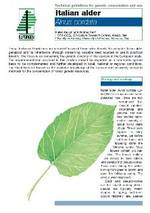Alnus cordata - Technical guidelines for genetic conservation and use for Italian alder
The first long-term action is to ensure the in situ conservation of existing populations according to dynamic gene conservation criteria. Italian alder can be managed in high forest or coppice systems. High forest management can be applied to mixed or pure stands. In both cases the best regeneration method for Italian alder is the creation of small clear cuts or strips (e.g. 20 x 200 m). The best results for regeneration are achieved where mineral soil is exposed, i.e. when top soil layers are for some reason disturbed by erosion or ‘ploughed’ by animals or by humans. A typical situation is represented on slopes along roads where light is plentiful and mineral soil is accessible. Especially in mixed stands, small subpopulations or 10-20 trees should be used as seed trees on clear cuts and strips.
In mixed beech-alder coppices, standards of Italian alder are usually allowed to develop to provide seed for growing natural regenaration, by taking advantage of suitable light conditions, of the more rapid partial mineralization of the litter and of the soil mineral layers made accessible by harvesting.
Seed should be collected from 30-40 well scattered trees per seed stand. Nearly ripe pseudo-cones should be collected in mid-October and early November to ensure that viable seeds material is obtained. The pseudo-cones should be dried at 38-40°C for 15-18 hours and between 5 and 6% air humidity.
Seeds can be stored up to about 2-3 years at 5-7°C and 5-6% air humidity. Indeed, concerning the seed preparation and pre-treatments, precise temperature and moisture requirements during the seed extraction and conservation should be met (temperature between -3° and +3°C and moisture of the seed-bed between 5 and 7%), as well as chilling conditions (±5°C and 70-80% moisture) should be carefully supplied. This process should induce a prompt, complete and quick germination of all seeds. In this way, possible selective micro-environmental effects will be reduced and most of the genetic variation present in the seed lots will be maintained. A similar strategy should be followed in the nursery, where the micro-site factors should be appropriate for maximum seedling survival and development. Extreme conditions for the range required by seedlings should be avoided (pH, minerals, temperatures, light, water supply, etc.) as these may impose selection pressures which only allow those that are best adapted to these conditions to survive.
Seed collection should be regularly rotated among several stands, so that different populations or subpopulations are sampled. Similarly, different groups of trees within a stand should be used for successive collections. Stands should be selected across a range of altitudes to ensure that the full range of genetic variation is captured.
Seedlings should be planted on a site that matches the requirements of the species. This will help ensure seedling survival. Seedlings should be carefully labelled to ensure that their origin can be traced, and should be the species included in the official list of species of the European directive on forest reproductive material trade.
Results of several controlled pollination experiments showed that seed orchards should not be based on mixtures of populations. Seedlings from within-population crosses performed better than those from between-population crosses. Possible problems of inbreeding can be reduced in single-population seed orchards by the inclusion of adequate numbers of clones.
Authors: Fulvio Ducci; Andrea Tani
Journal/Series: EUFORGEN Technical Guidelines for Genetic Conservation and Use
Publication Year: 2009
Publication Format: PDF
ISBN 13: 978-92-9043-786-4
Language: EN
Pages: 6 p.

